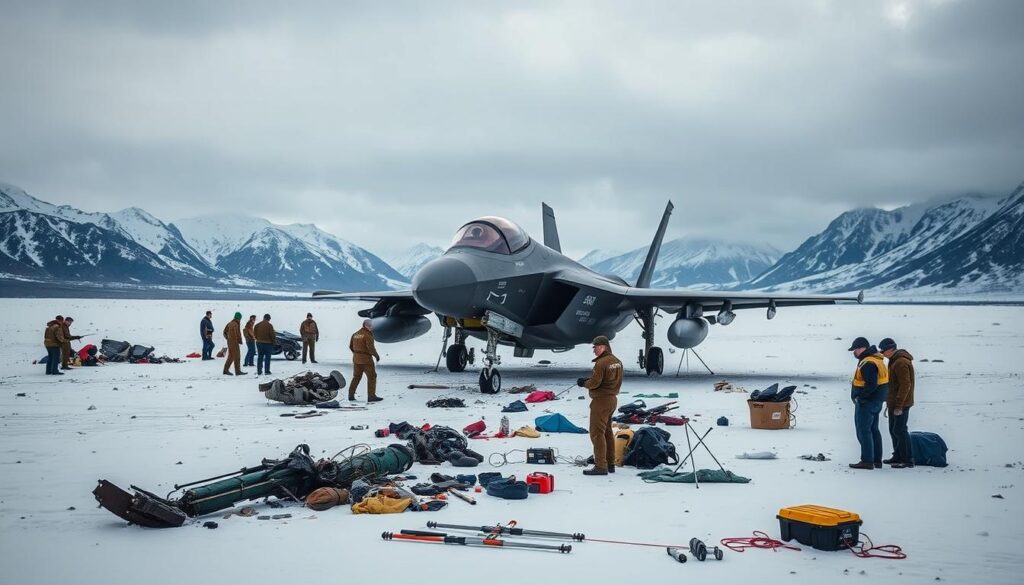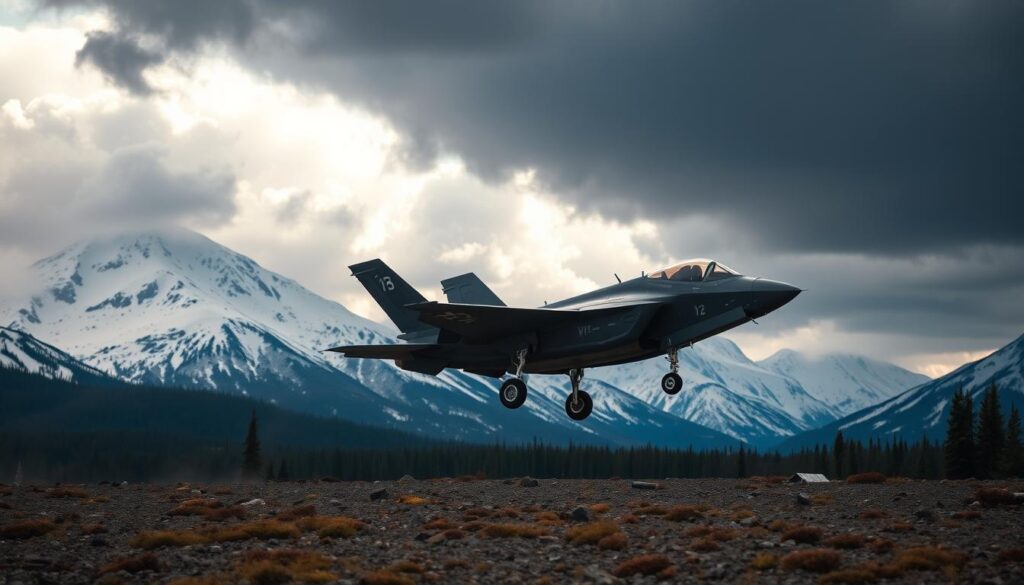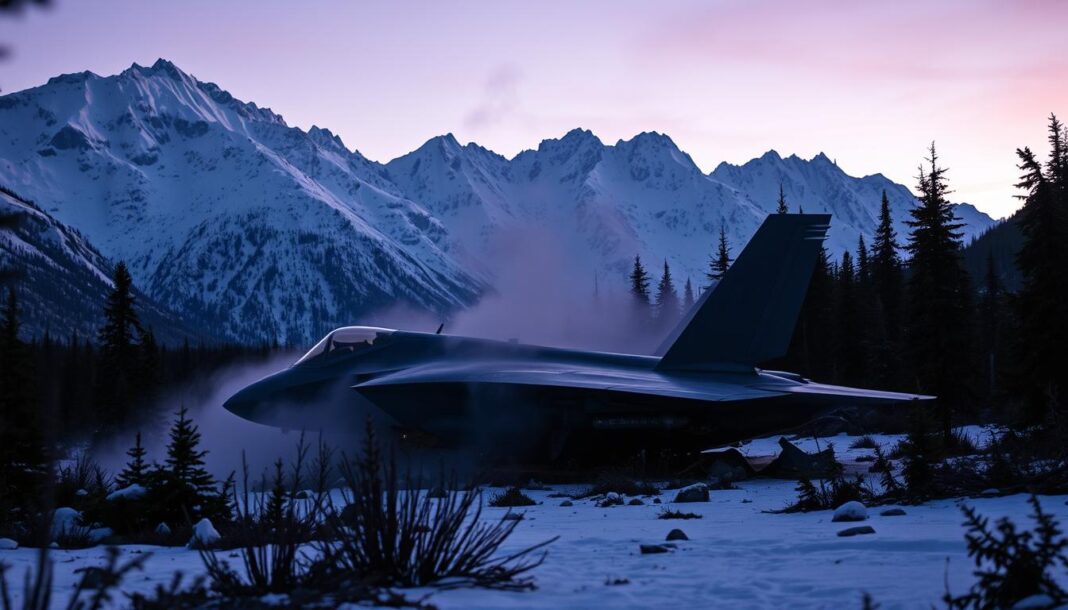“In war, there are no unwounded soldiers.” These words by José Narosky highlight the dangers of military flying. The recent crash of an F-35 Fighter Jet in Alaska shows these risks. It worries both the military and local people.
We will look into the crash, the emergency response, and the investigations. We aim to find out what caused this tragic event.
Key Takeaways
- The F-35 Fighter Jet Crash in Alaska shows the ongoing risks in military flying.
- The incident has led to quick rescue efforts and investigations.
- Local communities are watching how the crash will affect them.
- Emergency teams are working hard after the crash.
- Learning from aviation accidents is key to improving safety.
- This crash adds to the history of F-35 operations.
Overview of the Incident
The F-35 Fighter Jet Crash in Alaska happened on [insert date]. It involved a U.S. military aircraft. The plane was on a routine training mission when it faced problems.
It crashed in [insert specific location in Alaska].
It seems bad weather might have caused the crash. As teams worked to understand what happened, they looked into how weather affects military flights. They also thought about what this means for future missions in tough weather.
Details of the F-35 Fighter Jet Crash in Alaska
The recent crash of the F-35 fighter jet has raised many questions. People want to know about its advanced features and how it works. Looking into this incident helps us understand what happened and the jet’s performance.
Aircraft Model and Specifications
The F-35 Lightning II is a top-notch fighter jet. It’s famous for its stealth and ability to do many things. Key features include:
- Maximum speed: 1,200 mph
- Combat range: 1,380 miles
- Advanced avionics for aerial, ground, and maritime operations
These qualities make the F-35 a key player in today’s air battles. It meets the needs of different combat situations.
Timeline of Events Leading to the Crash
The timeline of the f-35 crash shows a series of worrying moments. The jet took off at about 10:00 AM and faced problems soon after. The exact issues are unclear, but contact with air traffic control stopped by 10:15 AM. This suggests a serious problem.
Local emergency services were alerted soon after. They were ready to help with the unfolding situation.
Initial Response and Rescue Operations
The F-35 fighter jet crash in Alaska led to a quick response from emergency services. Teams worked together to keep the pilot safe and understand the situation. Their goal was to act fast and effectively.
Emergency Services Involved
The Alaska National Guard and local police were key in the response. They used planes and ground teams to reach the crash site. Helicopters and ground units worked together, facing the tough terrain.
Survivors and Injuries Reported
The pilot ejected safely before the crash, which was a major relief. Though the pilot had minor injuries, they were not serious. Thanks to the quick work of emergency services, the survivors were kept safe.
Alaska Military Accident Investigation
The U.S. Military’s Air Force Safety Investigation Board has started a detailed look into the recent alaska military accident. They aim to find out important details about the incident. They will collect evidence from the crash site.
As part of the investigation details, they will talk to people involved. This will help them understand what happened. Knowing this is key to keeping military operations safe and responsible.
This careful method shows the military’s promise to be open. It also shows their effort to make safety better based on what they learn.
Eyewitness Accounts of the Crash
The F-35 crash in Alaska has caught the attention of the local community. *Eyewitness accounts Alaska* give us a look at what happened from those who saw it. People reported hearing a loud noise and seeing the aftermath, showing how connected they are to the skies.
Local Reactions and Observations
After the crash, local forums buzzed with discussions and worries. Many said they heard a loud noise before it happened, which scared them. The sight of the crash was also shocking, causing widespread shock.
Some common reactions include:
- Expressions of disbelief about the incident occurring in their area
- Concerns regarding the safety of military flights in the vicinity
- Support for victims and their families
- Calls for increased transparency about military operations
The community’s strong feelings show how much the crash has affected them. With many sharing their thoughts online, there’s a growing need for talks on safety and awareness of military planes.
| Eyewitness Reactions | Comments |
|---|---|
| Startling Noise | “I heard a loud bang, and it shook my house.” |
| Shock and Awe | “I never thought something like this would happen here.” |
| Concerns for Safety | “We need to discuss the impact of military flights in our community.” |
| Support for Victims | “Our thoughts are with those affected by this tragedy.” |
Impact on Local Community and Environment
The recent crash of the F-35 fighter jet has brought up big concerns for the local community and the environment. People are worried about the safety of living near military operations in Alaska. They are questioning how airspace rules protect civilians and their homes during military drills.
Safety Concerns and Airspace Regulations
As worries grow, the need for better airspace rules is clear. Military activities near homes are a big issue. Here’s why we need to take action:
- Proximity to Population Centers: Military activities near homes are risky, even more so in emergencies.
- Environmental Impact: Jet fuel spills and debris can harm the environment, causing long-term damage.
- Communication and Transparency: Military leaders must talk openly to build trust and work together.
F-35 Crash News: What We Know So Far
The F-35 crash situation is changing, and we’re getting updates from many sources. Reports are giving us clues about the investigation and what military leaders are saying. These updates help us understand the big picture of the crash.
Timeline of Updates
- Day 1: The incident was first reported, catching a lot of media attention.
- Day 3: It was confirmed that a team was sent to check out the crash site.
- Day 5: Early findings showed that a deep dive into flight data was needed.
- Day 7: Meetings were held to talk about local worries.
- Current: Military leaders are working with aviation experts for a detailed review.
Aviation Accident Updates and Related Incidents
The recent F-35 fighter jet crash in Alaska has added to the growing list of aviation accidents. These incidents have raised concerns about pilot safety and aircraft reliability. As investigations continue, updates about related incidents highlight the need for strict oversight in aviation protocols.
Recent aviation accident news points to similar incidents with different aircraft models. This has sparked discussions on the impact of these events on safety measures. Updates on related incidents show trends that may shed light on issues with flight operations and aircraft maintenance.
- Increased reports of technical malfunctions among commercial and military aircraft.
- Calls for improved training procedures for pilots in emergency scenarios.
- Heightened scrutiny from aviation authorities and public stakeholders.
The F-35 crash is just one of many recent aviation accidents. It has sparked important discussions about industry practices. As the investigation unfolds, each update brings new information that shapes the evolving landscape of aviation safety. Comparisons with previous incidents of similar aircraft models will emerge in upcoming sections, seeking to uncover lessons that can enhance future operational protocols.
F-35 Investigation Details
The F-35 crash investigation is key to understanding what happened. Led by the Air Force’s Safety Board, a team of experts is on the case. They aim to find out what went wrong and how to prevent it in the future.
Key Players in the Investigation
The military investigation is a team effort. It includes:
- Air Force investigators
- Technical safety experts
- Operational pilots and engineers
- Weather specialists
This team is working together to find out why the F-35 crashed. They look at human, mechanical, and environmental factors.
Possible Causes Under Examination
Several causes are being looked into. Some include:
- Mechanical failure of the aircraft
- Adverse weather conditions at the time of the incident
- Human error, including pilot decision-making

Flight data and environmental conditions are being closely analyzed. The goal is to keep military operations safe in the future.
Potential Ramifications for the Military
The recent F-35 crash in Alaska has big implications for the U.S. military. The Air Force is already feeling the effects, leading to talks about safety rules and how to fly. It’s clear that training in Alaska’s tough environment will need to change to keep people and planes safe.
Top military leaders might rethink how they use F-35s. They might change how they fly these planes, making sure pilots are better trained. This could mean new rules for flying in tough weather and more safety steps.
The military will look closely at what happened to learn from it. This learning will help improve technology and make military actions better. By studying past incidents and training, the military can make smarter choices when facing challenges.
| Aspect | Current Situation | Potential Changes |
|---|---|---|
| Safety Regulations | Standard operating procedures in place | Review and update for Alaskan conditions |
| Operational Protocols | Existing training methodologies | Enhanced focus on risk assessment |
| Training Missions | Conducted under normal circumstances | Adjustments to adapt to unpredictable environments |
| Future Operations | Ongoing evaluations and assessments | Incorporation of lessons learned |
Importance of Pilot Training and Safety Protocols
In aviation, pilot training and safety protocols aviation are key to avoiding accidents. A good training program teaches pilots how to deal with tough situations. It also prepares them for unexpected challenges during flight.
The recent F-35 crash shows we need to keep training up to date. As we learn more from the investigation, we might change pilot training to include new lessons. This way, we can make flying safer and prevent future accidents.
Having strong safety protocols aviation helps pilots follow the same rules every time. This creates a culture where safety comes first. It makes pilots more likely to focus on safe flying practices.
Fighter Jet Emergency Landing Procedures
Emergency landing procedures for fighter jets are key to keeping pilots safe in tough times. These steps are essential for pilots to handle emergencies well.

Knowing what’s around you is critical. Pilots learn to keep an eye on the weather, the ground, and other planes. This helps them make smart choices when things go wrong.
Talking to air traffic control is also important. Pilots need to quickly tell the tower what’s happening. This helps the ground team get ready for the emergency landing.
Emergency checklists are a big part of these procedures. These lists guide pilots through different emergencies. They help pilots land safely. Some things on these lists include:
- Checking how the engines are doing
- Turning on emergency systems
- Changing fuel settings
- Getting ready to use the landing gear
Knowing these steps can really help in an emergency. Each one is made to keep pilots safe and efficient. This way, pilots can handle unexpected situations better.
| Emergency Procedure | Description |
|---|---|
| Engine Failure | Find out why it failed, stay in control, and land safely. |
| Fuel Leak | Watch the fuel, and land at the nearest airport. |
| Electrical Malfunctions | Use backup systems and follow the checklist for electronics. |
| Landing Gear Issues | Check if it’s working, and prepare for landing without it if needed. |
Historical Context of F-35 Incidents
The F-35 program has grown from lessons learned from past incidents. These events have shaped safety improvements and better pilot training.
Previous F-35 Crashes and Lessons Learned
Every crash has led to a detailed investigation and changes. These incidents have shown us the importance of technical reliability, pilot skill, and maintenance quality. They teach us valuable lessons for the future.
| Incident | Date | Lessons Learned |
|---|---|---|
| First Operational Crash | 2018 | Need for improved pilot training on emergency procedures. |
| Software Malfunction Incident | 2019 | Importance of rigorous software testing before deployment. |
| Landing Gear Failure | 2020 | Enhanced maintenance protocols for critical components. |
Conclusion
The recent F-35 crash in Alaska highlights the challenges in military aviation. It shows the need for safety and following rules. As investigations start, they will give us important information.
This info will help us understand what happened. It will also shape how military flying is done in the future.
Alaska aviation news will keep talking about this crash. Updates will tell us why it happened. This is key to making flying safer for everyone.
It will help improve how pilots are trained. It will also make sure safety steps are followed better.
This crash shows we must always be careful and change how we fly. By learning from such incidents, the military can get safer. It will protect its people and the communities it serves.


